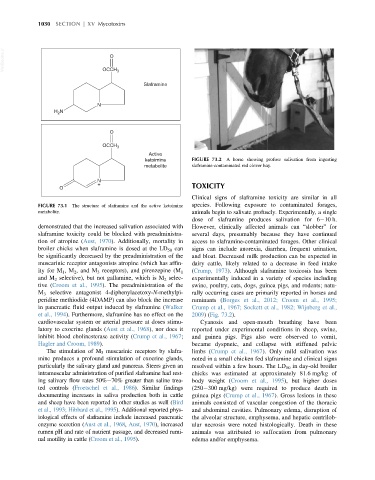Page 1098 - Veterinary Toxicology, Basic and Clinical Principles, 3rd Edition
P. 1098
1030 SECTION | XV Mycotoxins
VetBooks.ir OCCH 3
O
Slaframine
N
H N
2
O
OCCH 3
Active
ketoimine FIGURE 73.2 A horse showing profuse salivation from ingesting
metabolite slaframine-contaminated red clover hay.
N
+ TOXICITY
O
Clinical signs of slaframine toxicity are similar in all
FIGURE 73.1 The structure of slaframine and the active ketoimine species. Following exposure to contaminated forages,
metabolite. animals begin to salivate profusely. Experimentally, a single
dose of slaframine produces salivation for 6 10 h.
demonstrated that the increased salivation associated with However, clinically affected animals can “slobber” for
slaframine toxicity could be blocked with preadministra- several days, presumably because they have continued
tion of atropine (Aust, 1970). Additionally, mortality in access to slaframine-contaminated forages. Other clinical
broiler chicks when slaframine is dosed at the LD 50 can signs can include anorexia, diarrhea, frequent urination,
be significantly decreased by the preadministration of the and bloat. Decreased milk production can be expected in
muscarinic receptor antagonists atropine (which has affin- dairy cattle, likely related to a decrease in feed intake
(Crump, 1973). Although slaframine toxicosis has been
ity for M 1 ,M 2 , and M 3 receptors), and pirenzepine (M 1
and M 2 selective), but not gallamine, which is M 2 selec- experimentally induced in a variety of species including
tive (Croom et al., 1995). The preadministration of the swine, poultry, cats, dogs, guinea pigs, and rodents; natu-
M 3 selective antagonist 4-diphenylacetoxy-N-methylpi- rally occurring cases are primarily reported in horses and
peridine methiodide (4DAMP) can also block the increase ruminants (Borges et al., 2012; Croom et al., 1995;
in pancreatic fluid output induced by slaframine (Walker Crump et al., 1967; Sockett et al., 1982; Wijnberg et al.,
et al., 1994). Furthermore, slaframine has no effect on the 2009)(Fig. 73.2).
cardiovascular system or arterial pressure at doses stimu- Cyanosis and open-mouth breathing have been
latory to exocrine glands (Aust et al., 1968), nor does it reported under experimental conditions in sheep, swine,
inhibit blood cholinesterase activity (Crump et al., 1967; and guinea pigs. Pigs also were observed to vomit,
Hagler and Croom, 1989). became dyspneic, and collapse with stiffened pelvic
The stimulation of M 3 muscarinic receptors by slafra- limbs (Crump et al., 1967). Only mild salivation was
mine produces a profound stimulation of exocrine glands, noted in a small chicken fed slaframine and clinical signs
particularly the salivary gland and pancreas. Steers given an resolved within a few hours. The LD 50 in day-old broiler
intramuscular administration of purified slaframine had rest- chicks was estimated at approximately 81.6 mg/kg of
ing salivary flow rates 50% 70% greater than saline trea- body weight (Croom et al., 1995), but higher doses
ted controls (Froetschel et al., 1986). Similar findings (250 300 mg/kg) were required to produce death in
documenting increases in saliva production both in cattle guinea pigs (Crump et al., 1967). Gross lesions in these
and sheep have been reported in other studies as well (Bird animals consisted of vascular congestion of the thoracic
et al., 1993; Hibbard et al., 1995). Additional reported phys- and abdominal cavities. Pulmonary edema, disruption of
iological effects of slaframine include increased pancreatic the alveolar structure, emphysema, and hepatic centrilob-
enzyme secretion (Aust et al., 1968, Aust, 1970), increased ular necrosis were noted histologically. Death in these
rumen pH and rate of nutrient passage, and decreased rumi- animals was attributed to suffocation from pulmonary
nal motility in cattle (Croom et al., 1995). edema and/or emphysema.

